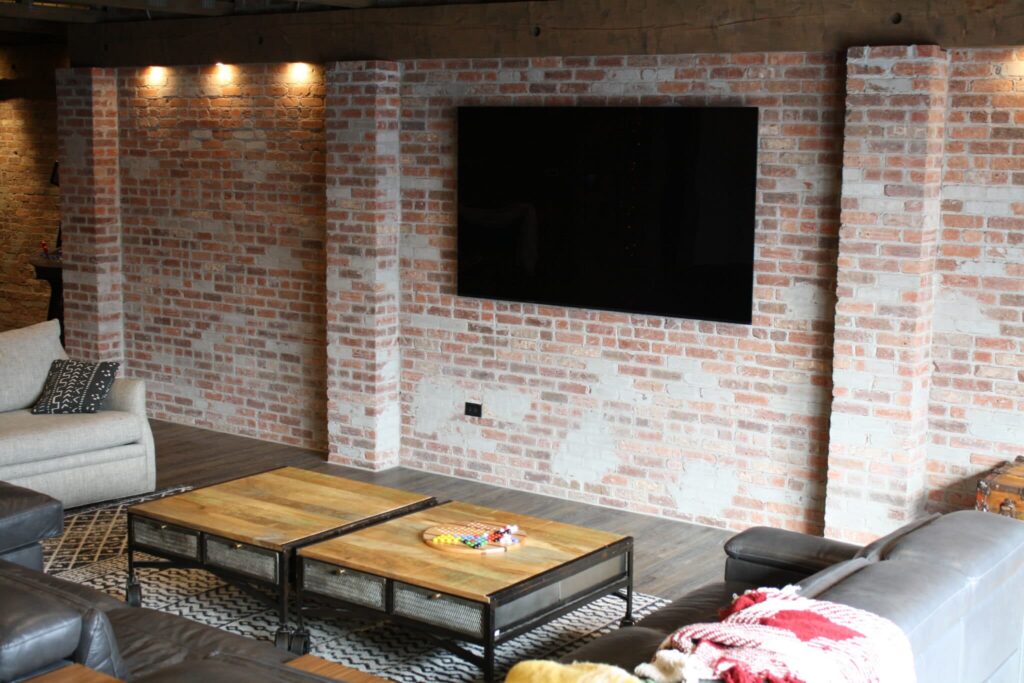You can’t skip planning for the proper wiring and networking when designing a home theater. Your audio and visual results won’t be the same. Before the wiring process beings, ask yourself these key questions:
- Do you want to prewire your home theater during the initial construction process?
- What kind of networking do you need for the best experience in your home theater room?
In this article, we will explain what you should know about home theater wiring and networking to get the best return on investment (and the best sound and audio).
Home Theater Network Wiring
Using the best available home theater wiring produces the best functionality. Knowing how it works is essential for anyone planning a home theater project. Home theaters have many components, and each must have the correct wiring for the best functionality. It helps to consider the wiring between the video distribution system, surround sound system, Blu-ray player, and any other devices you plan to use.
Wiring your home theater can be a breeze with some planning and effort. Once you have determined the equipment you want, system placement is next. Where will your TV or projector screen be mounted? Where will your rear speaker be located? Once you have a practical idea of where the system will go, wiring installation can begin. Be sure to leave enough slack for easy equipment access.
Some home theater wiring basics to keep in mind are:
- Wire length – Depends on the distance between the devices and outlets and if they are hidden or hung-up front.
- Matching connections – Varies on device and cable compatibility requirements, including video and audio.
- Wall plate outlets – Double-check proper hookup and installation.
Home theater wiring can seem daunting, and AIS can install and design them for you. When we create a new entertainment space, we follow the following primary wiring considerations for total design efficiency.
Pre-Wiring & Networking
Homeowners commonly confuse pre-wiring with visible cables and cords. Pre-wiring runs through your home’s frame to remain hidden and must be installed by home theater system installers. After it is painted over, the integrators finish the wiring by making connections to their necessary components.
There are a few pre-wiring factors to consider first before beginning the process of a home theater project, including:
- Number of speakers
- Rooms sizes
- Wiring maps
A wiring map is essential to keeping home theater wiring organized and easily trackable when it’s time to unplug. When you hire AIS, we will create a wiring map that labels each wire with the name of the device it plugs into and where the device is — so installation, programming, and service are faster and easier.
Speaker Wiring
Speaker wires connect speakers to an audio receiver and are available in different gauges and thicknesses. Depending on the speaker wattage and the distance between the speakers and the receiver, this can cause wiring changes. Selecting the correct gauge for your specific home theater project is crucial when choosing a speaker wire. The further you’re running the wire, the thicker the cord. For instance, more than 50 feet away would typically require a 12-gauge wire.
Leave the gauge sizing to the AIS home theater professionals. We can advise on the correct gauges to prevent problems with your sound quality.

Home Theater Cables
Using compatible equipment is critical when creating the perfect home automated theater. If you are using a Blu-ray player, you need an HDMI cable to connect it to the TV. Streaming devices might require an optical cable. Learn more about cable connection systems and how to select the right one for your home theater below.
HDMI
The most common cable connection is a fiber optic HDMI cable. HDMI stands for high-definition multimedia interface, and it’s used for transmitting video and audio. This cable’s best applications include a Blu-ray player, game console, or another digital device to a TV.
There are many benefits of using HDMI cables for home theater connection, including:
- Combines two separate cables into one
- Makes the cable connection process more efficient
- Transfers audio and video over long distances – ideal for connecting to a TV, Blu-ray player, or video game console.
- Carries 4K signal – compatible with 4K devices
While other types of cables can be used for home theaters, such as Ethernet or coaxial cable, fiber optic HDMI cables are generally considered the best option due to their high quality and reliability. At AIS, we can help you select the best cable option based on your needs.
Optical Audio Cables
An optical audio cable connects devices with digital optical audio ports. It’s a popular cable option for home theaters because it converts the audio signal into light and transmits it via cable. It provides a few benefits over traditional wires, such as clearer sound quality and less interference from electromagnetic fields. This system is ideal for home theater setups where there may be other electronic devices nearby that could cause interference.
Cables and Connections
Cables and connectors are vital components of any home theater. We highly recommend preliminary research and consulting with your local home theater integrators before deciding on a cable connection system.
Here’s a quick guide to understanding the various cables and connectors that go into home theaters:
- Coaxial Cable – Used for transmitting video and audio
- Component Video Cable – A high-definition cable used for videos and streaming.
- DVI Cable – A high-quality picture wiring to bring you TV and video.
- HDMI – A high-definition cable for videos such as TVs or projectors to display images.
- Optical Audio Cables – Used for transmitting audio
- S Video Cable – A cable that produces standard picture quality.
- VGA Connector Cable – Used for transmitting video
We understand that home theater cabling can be confusing. If you need help deciding on cable connections, contact AIS for help picking the right system for your needs.

Home Theater Wiring & Networking FAQs
Now that we’ve gone over wiring and cable systems, some common questions homeowners ask about home theater wiring and networking are below.
Can I wire the home theater myself?
Home theater wiring requires system integrators to prevent potential safety hazards and installation issues.
How do I keep all my home theater cables organized?
We suggest labeling each cable with its primary purpose, so it stays organized and easily trackable when it’s time to unplug.
What safety measures should I follow after my home theater cables are installed?
Home theaters are a significant investment, so you want to ensure that you use the proper equipment and take the necessary precautions. Try to keep pets and small children away from cables so nothing gets unplugged, chewed, or tripped on. We recommend not placing electronics too close to walls or other devices, so they have breathing room. Follow these simple tips to ensure your home theater runs for years.
Hire Home Theater System Installers Today
Do you have questions about home theater wiring and networking in Utah? Contact us about planning or retrofitting your Utah home theater.
Why should you choose AIS? We are certified by the Home Technology Association (HTA) to provide our customers with technical expertise and deliver enterprise-grade networking. When you hire a home automation company that meets HTA’s stringent standards, you know they’re technically qualified and trustworthy.
Our top-of-the-line home theater wiring services include helping homeowners choose the best features and installing the system adequately for optimal sound and picture quality.



